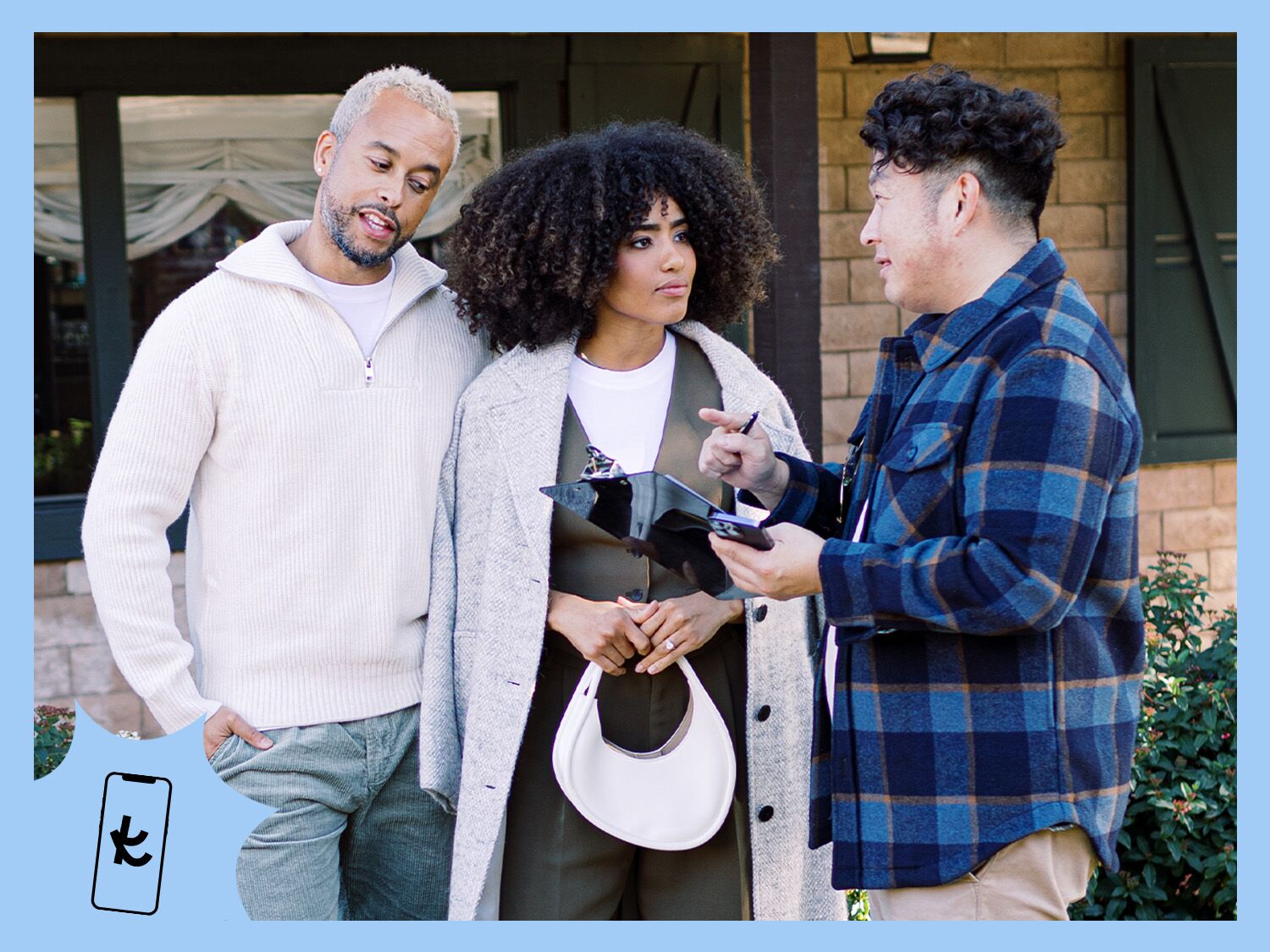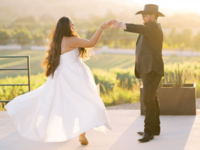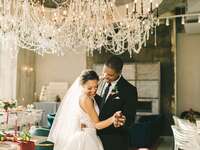These Wedding First Dance Tips and Back-Pocket Moves Won't Fail

So you're not the type of couple that wants to plan Dancing With the Stars-level choreography for your first dance. But you also don't want to succumb to the dreaded "middle school dance sway." Sounds like you need some wedding first dance tips. It's totally natural to feel nervous or awkward ahead of a formal dance under the spotlight—it's not like we've been waltzing away at balls over the years (unless someone is living my Bridgerton fantasy—please, let's be friends). To help you nail down some first dance moves for your wedding, we tapped a panel of pros to offer some tips and steps to consider before you toss on your dancing shoes.
In this article: Length | Tips | Easy Moves | Where to Find Inspiration
How Long Should Your First Dance Be?
A first dance should be between 2 to 4½ minutes (though, 2 to 3 minutes is the sweet spot), according to Deborah Joy Block, owner of The Wedding Dance Specialists in Alexandria, Virginia. This length allows you to soak up the moment, squeeze in a few wow-worthy moves and keep your dancing feet from getting too tired. If your favorite tune is longer than 3 minutes, don't fret. Your wedding DJ or band can help you cut the song to the perfect length.
First Dance Tips: How to Not Look Awkward
Bust a move, don't make your first dance a bust. If you feel awkward and uncomfy as a dancer (which is totally normal, by the way), it's easy to let your nerves get the best of you during your two-step. Comb through these expert-backed tips and tricks for how to execute your first dance at your wedding.
Take Dance Classes or Private Lessons
Even if you grew up as a theater/dance kid, there's always a good reason to take wedding dance lessons, whether it's brushing up on your technique or learning how to move with your partner. A few sessions with a pro (you can find one on The Knot Vendor Marketplace) will make it clear why you should take dance lessons. They're guaranteed to help you get comfortable moving your body and build confidence.
"New activities like dancing can feel awkward when they're unfamiliar," says Jessica Mays, owner of Windy City Wedding Dance in Chicago, Illinois. "By investing time into your dancing, you create muscle memory. Our clients who start early always look the most comfortable. They aren't even thinking about the steps, they're having a conversation on the floor, actually talking about a completely different topic, or they might be singing to each other." Use the links below to figure out how to find dance lessons in your area.
Wedding dance lessons by city and state:
Atlanta | Austin | Baltimore | Boston | Charlotte | Chicago | Cincinnati | Connecticut | Dallas | Denver | Houston | Jacksonville | Los Angeles | Miami | Minnesota | Nashville | New Jersey | New York | Philadelphia | Raleigh | Rhode Island | San Diego | San Francisco | Seattle | Tampa | Washington, DC
Select Your Song Wisely
"Choose a song with sentimental value and a clear, steady beat to follow—preferably a medium tempo," says Liza Marians, a wedding dance expert and owner of Dance With Liza in San Diego, California. "Tempo changes are okay if you have time to practice. If you're pressed for time, pick a song with a steady beat."
As you're considering first dance songs, try improvising a dance in your living room and see how comfortable you feel. If there's a song that's particularly meaningful to you and your partner (and isn't on our list of first dance songs to avoid) go for it. Your love for the song (and each other) will radiate.
Move in Sync
Sure, you don't want to be totally off beat, but it's more important to be in sync with your partner than to move to the music. "The main thing is that you move together as a couple, whether you're on the beat to the music or not," Block says. "And don't worry or concentrate too much on the footwork. Nobody in your audience is looking at your feet anyways."
Keep It Simple
A simple routine lets you focus on your partner, not just your footwork. Limiting your choreography to mostly beginner-friendly dance moves will make everything feel more natural (and therefore minimize the chance of you looking uncomfortable). Think about basic dance moves that come easily to you and build a routine around them.
Embrace Emotion
"Show the love, gratitude, happiness and romance in your eyes, smile, vibe and body language," Marians says. "The easiest thing couples can do to show their love is to maintain eye contact throughout the dance." You can even consider turning up the affection a notch.
"Take some time to kiss during the dance," says Block. "Kissing will relax you, show your guests that you're in love and give you a pause to think about your next move in your routine."
Hit the Highlights (and High Notes)
If you're feeling confident and coordinated enough to add some spice to your first dance, listen carefully to your music to determine where you can incorporate some flair. "Pay attention to exciting parts of the song such as an obvious phrase change, or the beginning or end of the chorus. Use those moments to throw in a spin, lean, dip or lift," says Marians.
Let It Linger
"I probably give this advice more than any other," says Marians. Hold dips and leans for a second or two, spin slowly to let your gown (if you're wearing one) flare out and extend your arms with intention. "Couples should pretend they're dancing underwater to give the dance a more graceful look."
Block also notes that these slower, lingering moments are prime for photo ops: "The key is to hold some of the poses for a slightly longer time and to let your photographer know in advance some of the poses that you'll incorporate into the dance," she says. "Maintaining good posture, which we teach to our students, is very important for good photos."
Practice Ahead of Time
"I can show couples some moves or a simple routine really quickly, but in order for them to execute it well and make it look natural, they need time to practice," says Marians. Even with a few accessible steps in your repertoire, a little spin rehearsal ahead of the wedding doesn't hurt.
For those with more-elaborate choreography, schedule a dance rehearsal designed to mimic your first-dance circumstances as closely as possible. Mays recommends collaborating with your wedding planner and venue to set up a day and time to dance in your reception space. Having someone film your rehearsal can also bring attention to anything that should be adjusted or refined.
And even if you're just going to wing your first dance without any predetermined choreography, you should still practice moving as one and explore some fun moves you can add in ad hoc on the day. (We can help with that below.)
Take Instagram Inspo With a Grain of Salt
"Couples show me wedding dance videos that they've found on social media and ask if I can teach them the dance moves," says Marians. "They don't realize that most of the dancers in the videos are professional ballroom dancers with years, if not decades, of experience…I often use the videos for inspiration and show them similar, but easier moves."
Be Kind to Each Other
This tip extends to all aspects of wedding planning, but the dance studio is an especially vulnerable place. If your partner isn't picking up the choreography as fast as you are, don't get frustrated. Some folks get stage fright and feel unnatural moving to music, let alone coordinating their steps with a tune and another person. Keep the energy surrounding your first dance positive and encouraging in and out of the studio.
Easy and Simple First Dance Moves
Wondering exactly how to dance for your wedding first dance? We've got you. Check out these back-pocket, basic dance steps for your wedding routine from Liza Marians that you can practice at home or even add in on the fly (if you're a spontaneous couple). Throw them in whenever the mood (or move) strikes.
The Step-Sway Switch
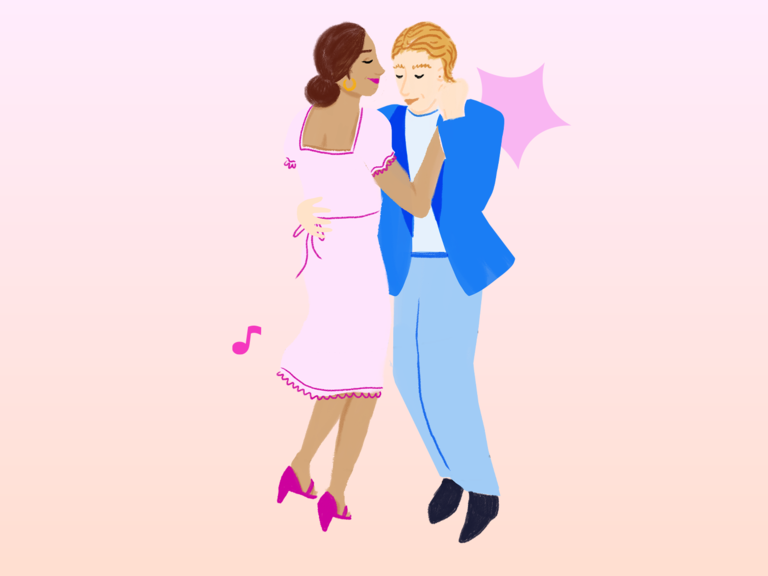
1. Begin with the basic step-and-touch move from side to side, mirroring your partner.
2. Plant both of your feet and then slowly sway your bodies back and forth.
3. Return to the step-and-touch move, but this time, move in a circle so your guests can admire you from all angles.
The Frame Flip
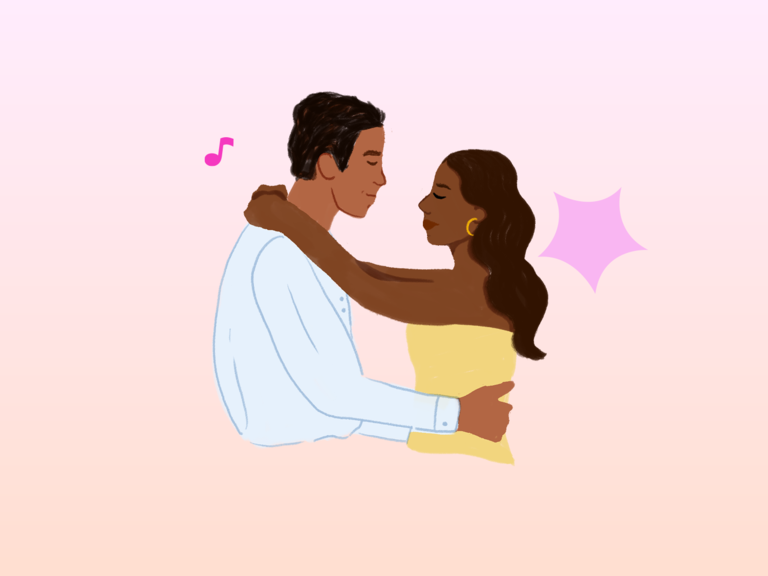
1. Start with an intimate hold, wrapping your arms tightly around each other (the "prom hold"). One partner can rest their head on the other's shoulder, or they can take the other's right hand in their left and place it over their own heart.
2. Shift to a more formal ballroom frame. The leading partner's right hand is on the following partner's shoulder blade with their right elbow up, and their left hand is at a similar height holding the follower's hand. The ballroom frame is useful for spins and other traditional moves.
3. Execute any relevant steps in the ballroom frame and switch back and forth to and from the prom hold as you see fit.
The Hello-Goodbye

1. Varying levels of closeness will add flair without complicated choreography. Start close together; dance cheek-to-cheek or with the follower's back against the leader's front, swaying back and forth in a sweetheart position.
2. Open up your position and add some space between you. Keep one hand clasped with your partner's and the other on their shoulder or waist. Both partners should position their hand-holding arms with a soft bend in the elbow.
The Simple Spin
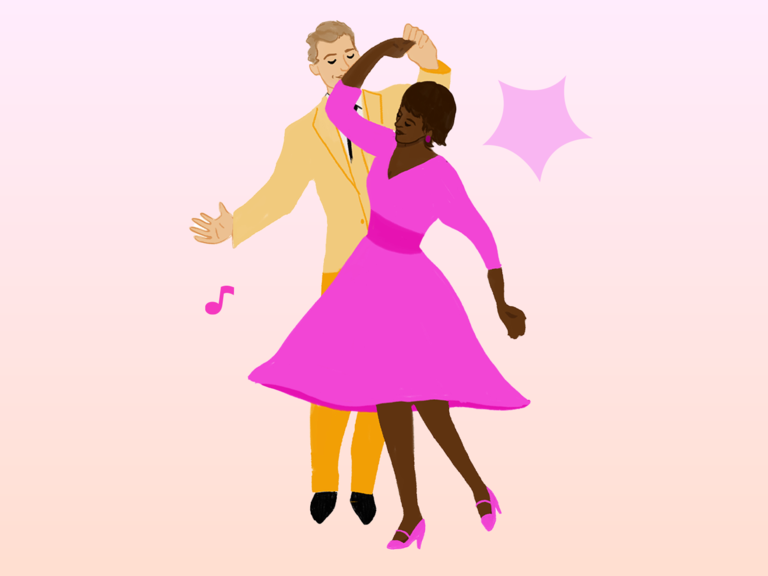
1. The leader steps forward on one foot and raises their arm on the same side—the arm that is currently holding the follower's hand.
2. As the leader makes a halo above the follower's head with their raised arm, the follower spins (counterclockwise if the leader is stepping on the right foot, clockwise if the left) underneath their arm over the course of four or eight beats in the music.
3. The leader brings their arm back down and shifts the couple back into the ballroom frame (one hand holding the other partner's and the other hand on their shoulder or waist).
The Dramatic Dip

1. The leader supports the follower's middle back with one hand as they lunge forward with one leg (left leg for left dip, right leg for right dip), holding a stable core to support the follower's weight.
2. Once they feel that mid-back pressure, the follower will gently bend backward, also tightening their core for stability. As they descend, their outside leg (with a pointed toe) lifts up. They can choose to look at their partner, at their guests or toss their head back for a little flair. They could place their hand on their partner's arm (which is around their waist) or let it extend.
Where to Find Inspiration for Your First Dance
Figuring out how to slow dance for your wedding goes beyond just nailing a few simple steps. Sometimes you need a little inspo to see how everything comes together. Here are a few places to look for first-dance inspiration—and they might not be where you think.
Real Couples
As Marians aforementioned, so many of the dance moves you'll see on social media are pro dancers. Use those videos for entertainment and motivation, but look to clips of real couples' first dances to pull tangible inspiration. There are tons of first dances to watch on YouTube, some of which could even be to your exact song, if it's popular. You're much more likely to come across actionable steps this way, but still remember that you don't know the time or the price these couples spent on dance lessons, or if one or both members of the couple have a dance background.
Song Lyrics
Stumped for steps? Listen to your song's lyrics to get inspired. For example, if your tune mentions "falling for" someone, a dip might be fitting. If it says something about "being in your arms" step closer or let the follow spin into the lead to be held.
Your Relationship
If you keep your first dance true to how you two interact, it'll look natural, joyful and full of love. Incorporate a knowing gesture, secret handshake or any other special wink to your relationship into your choreography. But most of all, don't be afraid to be silly or sentimental—this is a celebration of you, not perfect dance technique.



